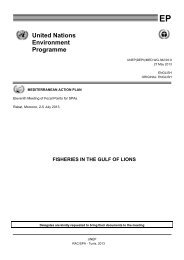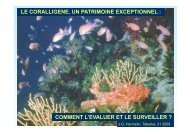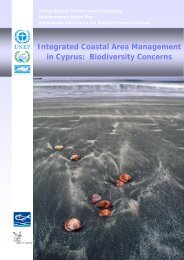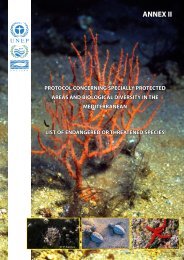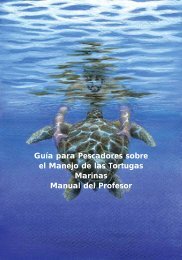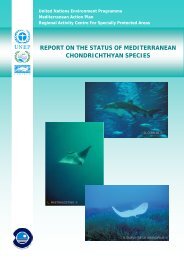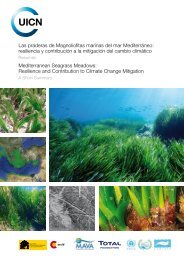Proceedings of the Second Mediterranean Symposium on Marine
Proceedings of the Second Mediterranean Symposium on Marine
Proceedings of the Second Mediterranean Symposium on Marine
You also want an ePaper? Increase the reach of your titles
YUMPU automatically turns print PDFs into web optimized ePapers that Google loves.
PROCEEDINGS OF THE SECOND MEDITERRANEAN SYMPOSIUM ON MARINE VEGETATION (ATHENS, 12-13 DECEMBER 2003)<br />
78<br />
MATERIALS AND METHODS<br />
Thalli were collected in <str<strong>on</strong>g>the</str<strong>on</strong>g> following sites: <str<strong>on</strong>g>the</str<strong>on</strong>g> sou<str<strong>on</strong>g>the</str<strong>on</strong>g>rn littoral <str<strong>on</strong>g>of</str<strong>on</strong>g> Bari (Adriatic Sea,<br />
41°6’58”N, 16°53’38”E) for H. ligulatum; a small marine cave, <str<strong>on</strong>g>the</str<strong>on</strong>g> Grotta della Regina<br />
at Torre a Mare, in <str<strong>on</strong>g>the</str<strong>on</strong>g> district <str<strong>on</strong>g>of</str<strong>on</strong>g> Bari (Adriatic Sea, 41°5’21”N, 16°59’38”E) for Gelidiella<br />
sp.; Torre Borraco (Taranto, I<strong>on</strong>ian Sea, 40°18’25”N, 17°40’3”E) for Batophora sp.<br />
Specimens are kept at <str<strong>on</strong>g>the</str<strong>on</strong>g> herbarium <str<strong>on</strong>g>of</str<strong>on</strong>g> <str<strong>on</strong>g>the</str<strong>on</strong>g> Department <str<strong>on</strong>g>of</str<strong>on</strong>g> Biology and Plant Pathology.<br />
Observati<strong>on</strong>s were made <strong>on</strong> freshly collected, formalin-preserved, lab-cultured material<br />
and <strong>on</strong> herbarium specimens.<br />
Vegetative characteristics reliable for <str<strong>on</strong>g>the</str<strong>on</strong>g> diagnosis <str<strong>on</strong>g>of</str<strong>on</strong>g> <str<strong>on</strong>g>the</str<strong>on</strong>g> genus Batophora were<br />
observed <strong>on</strong> 50 thalli randomly collected in <str<strong>on</strong>g>the</str<strong>on</strong>g> field and compared with those <str<strong>on</strong>g>of</str<strong>on</strong>g><br />
specimens <str<strong>on</strong>g>of</str<strong>on</strong>g> B. oerstedii and B. occidentalis obtained from Chetumal Bay (Mexico). Labcultures<br />
were performed in order to observe thallus morphogenesis and possibly to<br />
induce gametophore producti<strong>on</strong>. Substrates col<strong>on</strong>ised by Batophora sp., collected in <str<strong>on</strong>g>the</str<strong>on</strong>g><br />
field, were <str<strong>on</strong>g>the</str<strong>on</strong>g> culture material. Erd-Schreiber medium, changed weekly, was used.<br />
Germanium dioxide (6 ppm) was added to <str<strong>on</strong>g>the</str<strong>on</strong>g> medium in order to reduce diatom<br />
c<strong>on</strong>taminati<strong>on</strong>. Tests were carried out in growth chambers under <str<strong>on</strong>g>the</str<strong>on</strong>g> following<br />
c<strong>on</strong>diti<strong>on</strong>s: 90 µmol m -2 s -1 PFD, 18° and 26°±1°C, 12:12 or 16:8 light/dark regimes.<br />
Some Apulian thalli <str<strong>on</strong>g>of</str<strong>on</strong>g> Batophora sp. resembled Dasycladus vermicularis (Scopoli)<br />
Krasser so that a comparative study with <str<strong>on</strong>g>the</str<strong>on</strong>g> latter species was performed.<br />
RESULTS<br />
Thalli <str<strong>on</strong>g>of</str<strong>on</strong>g> H. ligulatum were collected for <str<strong>on</strong>g>the</str<strong>on</strong>g> first time in June 1998 (Fig. 1a) in shaded<br />
crevices, at 1-3 m depth. Apulian gametophytes have a small attachment disc, about 1 mm<br />
in diam., from which <strong>on</strong>e to several flattened fr<strong>on</strong>ds arise. Plants are brownish red, up to<br />
200 mm l<strong>on</strong>g and 5-20 mm broad. The stipe expands into irregularly branched blades,<br />
tapering at <str<strong>on</strong>g>the</str<strong>on</strong>g> ends, proliferating from both margins and surfaces. The cortex c<strong>on</strong>sists <str<strong>on</strong>g>of</str<strong>on</strong>g> 2-<br />
3 layers; <str<strong>on</strong>g>the</str<strong>on</strong>g> outer cortical cells are small and polyg<strong>on</strong>al in surface view. The medulla ranges<br />
from ra<str<strong>on</strong>g>the</str<strong>on</strong>g>r compact to very loose and lacunose; it is obliquely crossed by few cylindrical<br />
filaments, about 8 µm in diameter, and by l<strong>on</strong>g arms <str<strong>on</strong>g>of</str<strong>on</strong>g> pseudostellate cells (Fig. 1b).<br />
Fig. 1. H. ligulatum. (a) Habit <str<strong>on</strong>g>of</str<strong>on</strong>g> <str<strong>on</strong>g>the</str<strong>on</strong>g> herbarium specimen collected at Bari, Adriatic Sea; (b) cross secti<strong>on</strong> <str<strong>on</strong>g>of</str<strong>on</strong>g> a blade.




